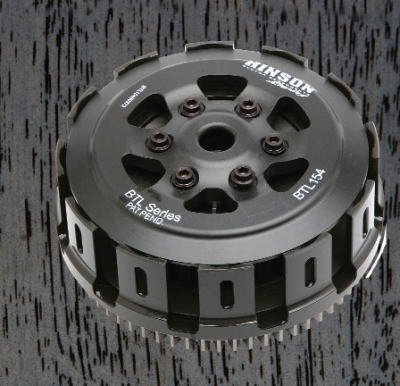MXA PRODUCT TEST: HINSON BTL SLIPPER CLUTCH; The Engine Part That Fixes Your Bike’s Rear Suspension
MXA PRODUCT TEST:
HINSON BTL SLIPPER CLUTCH
WHAT IS IT? An engine part that does its best work as a suspension component.
WHAT’S IT COST? $1149.99 (with your clutch basket), $1695.99 (complete).
CONTACT? www.hinsonracing.com or (909) 946-2942.
 WHAT’S IT DO? By its very name, it is obvious that a slipper clutch slips. The Hinson Back Torque Limiter clutch (BTL) doesn’t slip all the time, only when the unique clutch mechanism senses deceleration. When you chop the throttle, like before braking bumps, half way through the whoops or down steep, bumpy hills, the BTL slipper clutch acts as though you’ve pulled the clutch lever in.
WHAT’S IT DO? By its very name, it is obvious that a slipper clutch slips. The Hinson Back Torque Limiter clutch (BTL) doesn’t slip all the time, only when the unique clutch mechanism senses deceleration. When you chop the throttle, like before braking bumps, half way through the whoops or down steep, bumpy hills, the BTL slipper clutch acts as though you’ve pulled the clutch lever in.
Don’t confuse a slipper clutch with an automatic clutch (like the Rekluse Z-Start clutch). It is not an automatic; you still have to pull the clutch in to start, shift or stop. It just slips when you back off on the throttle.
How does it work? A slipper clutch is basically two clutches in one. The first clutch is activated by the clutch lever. The second clutch is activated by centrifugal force within the spinning clutch basket. When the clutch’s internal moving parts decelerate, the difference in momentum disengages the clutch.
WHAT STANDS OUT? Here’s a list of things that stand out with the Hinson BTL slipper clutch.
(1) Performance. Although the BTL is a clutch, and it is inside your engine, its biggest advantages show up in the chassis (where it works as an anti-chain torque device). When you chop the throttle on a big four-stroke, the decompression of the engine slows forward momentum dramatically. This creates wheel hop, which you feel as kicking on the entrance of turns or in the whoops. A slipper clutch significantly lessens wheel hop in braking bumps and at the end of long whoop sections. Additionally, it lessens decompression braking and makes a four-stroke feel like a two-stroke on the entrance to turns.
(2) Hook up. As if that isn’t enough, the Hinson slipper clutch hooks up more positively under acceleration, which makes it better in roll-on situations. When you combine the ability to freewheel into a turn with less wheel hop and better hookup on acceleration, you get quicker corner speeds. The last benefit of a slipper clutch is that it works as an anti-stall device. Although a slipper clutch can’t guarantee that you won’t stall your bike in a tight corner, it does make it less likely to cough, because the BTL clutch automatically disengages under deceleration (giving you time to get to the lever).
(3) Choices. Hinson offers two versions of its BLT slipper clutch. First, is a complete slipper clutch with all the parts needed. Second is an inner hub/pressure plate kit that uses your stock clutch basket.
WHAT’S THE SQUAWK? We have three:
(1) It doesn’t feel like a normal clutch, and most MXA test riders didn’t like the fact that it couldn’t be slipped out of a corner like a conventional clutch. This was the most common complaint.
(2) Spring pressure on the BTL is provided by a Belleville washer. It isn’t as well understood as changing six coil springs.
(3) There is a learning curve to riding with a slipper clutch (it is hard to resist using the clutch as much as you used to) and the key to making the most of a slipper clutch is to let it do its own work without interfering with your itchy clutch hand.

For AMA National and Supercross riders, we would consider this a five-star product (and many factory teams use slipper clutches), but once you get beyond the rare air of factory riders and consecutive Supercross whoops, the star count comes down some. For riders on smoother tracks or with less serious intent, it is still a three-star product. It is first and foremost a suspension device.





Comments are closed.